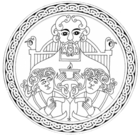Clans of Ireland
 |
|
| Formation | 1989 |
|---|---|
| Founder | Rory O'Connor Kerry |
| Type |
Irish clans Irish genealogy Gaelic culture |
| Headquarters | Ireland |
| Website | clansofireland.ie |
Clans of Ireland (Irish: Finte na hÉireann) is an independent organisation established in 1989 with the purpose of creating and maintaining a Register of Irish Clans. The Patron of Clans of Ireland is Michael D. Higgins, President of Ireland.
The growing influence of the Gaelic League at the turn of the twentieth century rekindled an interest in Gaelic culture and prompted a cultural revival and interest in Irish Clans which continues today. In the 1940s Edward MacLysaght, the Chief Herald of Ireland, drew up a list of Irish clans (see MacLysaght, Irish Families) and began to publish a number of works on the history and background of Irish families. Irish “clans“ were organised in the latter half of the twentieth century under the umbrella body, Clans of Ireland, or Finte na hÉireann. Membership is open to family groups with proven Irish history and genealogy.
Brehon Law, the ancient legal system of Ireland clearly defined the clan system in pre-Norman Ireland, which began to collapse following the Tudor Conquest. The Irish, when speaking of themselves, employed their term 'clan' which means "family" in Irish and generally refers to a large family grouping. The Gaelic word 'fine' (pron. fina) describes the smaller, more intimate family grouping. Scholars previously disagreed about whether it was better to use the terms "sept" or "clan". Historically, the term 'sept' was not used in Ireland until the nineteenth century. It was often argued that the English word 'sept' is most accurate when referring to the 'fine', a sub-group within a large clan. Related Irish 'fine' or septs often belong to larger clan groups, sometimes referred to as tribes in English, such as the Dál gCais, Uí Néill, Uí Fiachrach, and Uí Maine. As the population of clans increased, the 'fine' became more significant and by the tenth century these sub-groups took the name of their own sub-chief, (Ceann Fine); such as the Mac Aodhagáin, the sons of Aodhagáin (anglicised to Egan), who were part of the extensive Uí Maine Clan, or Ó hUigin, grandsons of Uiginn (anglicised to Higgins), part of Cenél Fiachach founded by Fiachu Mac Neill, son of Niall of Tara. In this way many of the Irish surnames, in use today, were developed.
In 1989 Rory O'Connor, the elected Chieftain of the O'Connor Kerry Clan, set out to bring about a revival in the organisation of the Irish Clans. It was his intention that there would be a branch of each Irish clan organised in every county in Ireland and in every continent around the world. It was also his ambition that once the individual clans had been organised there would be a mass gathering of all of the clans at the Hill of Tara, the symbolic seat of the Irish High King. To this end, he wrote to newspapers, cultural organisations and individuals across Ireland encouraging people to begin to organise themselves in clan associations. He was successful in requesting and obtaining support from Mr. Martin Dully, then Chairman of Bórd Fáilte (Irish Tourist Board), and the Minister for Tourism at the time as well as the Chief Herald of Ireland. The response from the general public in Ireland and oversees was quite positive and on the 6th of November 1989 a press conference was held in Dublin to announce the opening of the office of Clans of Ireland which was to be initially located at the Genealogical Office in Dublin. The purpose of Clans of Ireland was to support and co-ordinate the activities of the various clan organisations in Ireland and around the world and to create and maintain a Register of Clans. In 1990, Clans of Ireland obtained charitable status and also became a limited company.
...
Wikipedia
